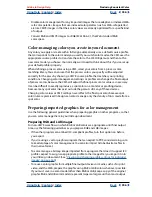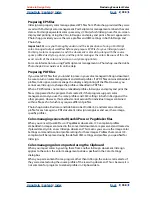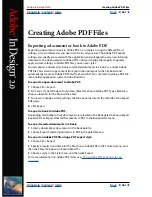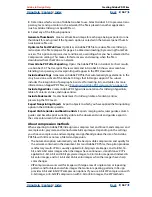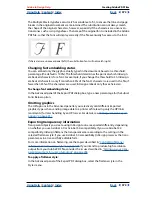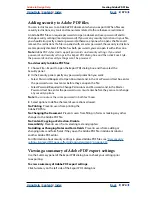
Using Help
|
Contents
|
Index
Back
362
Adobe InDesign Help
Creating Adobe PDF Files
Using Help
|
Contents
|
Index
Back
362
Producing Adobe PDF files for a high-resolution
composite workflow
Using InDesign, you export your document to a composite Adobe PDF file called a
digital
master
. These digital masters are compact, reliable files that you or your service provider
can view, edit, organize, and proof. Then, at the appropriate time in the workflow, your
service provider can either output the Adobe PDF file directly, or process it using tools
from various sources for such post-processing tasks as preflight checks, trapping,
imposition, and color separation.
Recommended tools for print publishing
In a typical print publishing workflow, documents are distributed in the format of the
authoring application (called the
native
format). Once approved, the files are saved in
PostScript or a proprietary format for prepress work and final printing. Because applica-
tions generate PostScript in so many different ways, PostScript files may be arbitrarily large
and complex. In addition, such reliability problems as missing fonts, corrupt files, missing
graphics elements, and unsupported features at output time can result in output
problems.
In response, Adobe and its partners are working to create a reliable publishing workflow
solution. Adobe is continually addressing the workflow needs of service providers, and
recommends that you visit the Adobe Web site at www.adobe.com often for the latest
developments. Currently, Adobe addresses publishing workflow needs by providing an
integrated system of several technologies:
•
Adobe Acrobat 5.0 software, with its support for Adobe PDF version 1.4.
•
Adobe PostScript 3 printing technology, for device-independent support, Adobe In-RIP
Trapping, in-RIP color separations, and smooth blends.
•
Adobe Extreme
™
, which combines options for direct Adobe PDF output.
•
Adobe InDesign, with its high-resolution page layout capabilities and direct Adobe PDF
processing.
Switching to an Adobe PDF workflow
Many large publishers use Adobe PDF to streamline their review and production cycles.
For example, numerous magazines and newspapers have adopted Adobe PDF as the
standard format for delivering ads to local publishing offices via satellite or ISDN lines.
Adobe PDF enables local publishers to instantly view an ad exactly as it was designed,
make late-stage text edits, and reliably print from any computer.
A high-resolution composite Adobe PDF workflow typically includes a PostScript 3 output
device whose RIP supports in-RIP separations. Therefore, if your output device uses
PostScript Level 2 or does not support in-RIP separations, use a preseparated PostScript
printing workflow. (See
“Two common print workflows” on page 414
.)
To produce Adobe PDF files for a high-resolution composite workflow:
1
Prepare the document for exporting to Adobe PDF.
2
Export using the [Press] style—the default Adobe PDF style for high-resolution output.
3
Proof and correct the Adobe PDF file.
4
Hand off the press-optimized Adobe PDF file to the prepress service provider.









